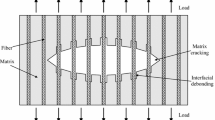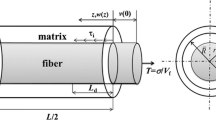Abstract
A model for a macroscopic crack transverse to bridging fibers is developed based upon the Coulomb friction law, instead of the hypothesis of a constant frictional shear stress usually assumed in fiber/matrix debonding and matrix cracking analyses. The Lamé formulation, together with the Coulomb friction law, is adopted to determine the elastic states of fiber/matrix stress transfer through a frictionally constrained interface in the debonded region, and a modified shear lag model is used to evaluate the elastic responses in the bonded region. By treating the debonding process as a particular problem of crack propagation along the interface, the fracture mechanics approach is adopted to formulate a debonding criterion allowing one to determine the debonding length. By using the energy balance approach, the critical stress for propagating a semi-infinite fiber-bridged crack in a unidirectional fiber-reinforced composite is formulated in terms of friction coefficient and debonding toughness. The critical stress for matrix cracking and the corresponding stress distributions calculated by the present Coulomb friction model is compared with those predicted by the models of constant frictional shear stress. The effect of Poisson contraction caused by the stress re distribution between the fiber and matrix on the matrix cracking mechanics is shown and discussed in the present analysis.
Similar content being viewed by others
References
W. A. Curtin, “Stress-strain behavior of brittle matrix composites,” in: Comprehensive Composite Materials. Vol. 4, Elsevier Science Ltd. (2000), pp. 47–76.
V. Kostopoulos and Y. Z. Pappas, “Toughening mechanisms in long fiber ceramic matrix composites, ” in: Comprehensive Composite Materials. Vol. 4, Elsevier Science Ltd. (2000), pp. 95–114.
J. Aveston, G. A. Cooper, and A. Kelly, “Single and multiple fracture,” in Proc. of Conference “Properties of Fiber Composites,” National Physical Laboratory, IPC, England (1971), pp. 15–26.
J. Aveston and A. Kelly, “Theory of multiple fracture of fibrous composites,” J. Mater. Sci., 8, No. 3, 352–362 (1973).
B. Budiansky, J. W. Hutchinson, and A. G. Evans, “Matrix fracture in fiber-reinforced ceramics,” J. Mech. Phys. Solids, 34, No. 2, 167–189 (1986).
M. Sutcu and W. B. Hillig, “The effect of fiber-matrix debond energy on the matrix cracking strength and the debond shear strength,” Acta Metall., 38, No. 12, 2653 (1990).
Y. C. Chiang, “On fiber debonding and matrix cracking in fiber reinforced ceramics,” J. Compos. Sci. Technol., 61, No. 12, 1743–1756 (2001).
Y. C. Gao, Y. W. Mai, and B. Cotterell, “Fracture of fiber-reinforced materials,” J. Appl. Math. Phys. (ZAMP), 39, No. 7, 550–572 (1988).
J. W. Hutchinson and H. M. Jensen, “Models of fiber debonding and pull out in brittle composites with friction,” Mech. Mater., 9, 139–163 (1990).
Y. C. Chiang, “On crack-wake debonding in fiber reinforced ceramics,” Eng. Fract. Mech. 65, No. 1, 15–28 (2000).
W. Wu, I. Verpoest, and J. Varna, “A novel axisymmetric variational analysis of stress transfer into fibres through a partially debonded interface,” J. Com pos. Sci. Technol., 58, 1863–1877 (1998).
J. A. Nairn and Y. C. Liu, “Stress transfer into a fragmented anisotropic fiber through an imperfect interface,” Int. J. Solids Struct., 34, 1255–1281 (1996).
U. Mbanefo and R. A. Westmann, “Axisymmetric stress analysis of a broken debonded fiber,” ASME Trans. J. Appl. Mech., 57, 654–660 (1990).
D. Hull and T. W. Clyne, An Introduction to Composite Materials, 2nd Ed., Cambridge University Press (1996).
P. L. Lawrence, “Some theoretical considerations of fibre pull-out from an elastic matrix,” J. Mater. Sci., 7, No. 1, 1–6 (1972).
A. Takaku and R. G. C. Arridge, “The effect of interfacial radial and shear stress on fibre pull-out in composite materials,” J. Phys. D: Appl. Phys., 6, No. 11, 2038–2047 (1973).
H. Stang and S. P. Shah, “Failure of fibre-reinforced composites by pull-out fracture,” J. Mater. Sci., 21, No. 3, 953–957 (1986).
Author information
Authors and Affiliations
Additional information
Russian translation published in Mekhanika Kompozitnykh Materialov, Vol. 43, No. 2, pp. 171–190, March–April, 2007.
Rights and permissions
About this article
Cite this article
Chiang, YC. Effect of Coulomb friction on the fiber/matrix debonding and matrix cracking in unidirectional fiber-reinforced brittle-matrix composites. Mech Compos Mater 43, 113–126 (2007). https://doi.org/10.1007/s11029-007-0012-4
Received:
Revised:
Issue Date:
DOI: https://doi.org/10.1007/s11029-007-0012-4




